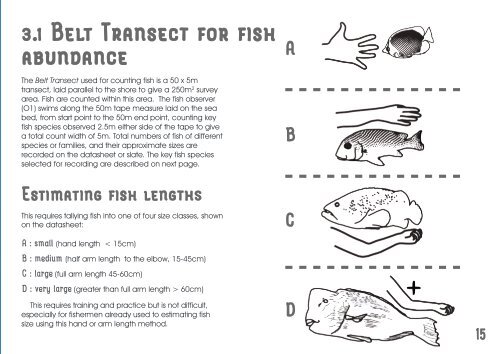TNC-CORDIO coral reef monitoring manual_book_coral1
TNC-CORDIO coral reef monitoring manual_book_coral1
TNC-CORDIO coral reef monitoring manual_book_coral1
You also want an ePaper? Increase the reach of your titles
YUMPU automatically turns print PDFs into web optimized ePapers that Google loves.
3.1 Belt Transect for fish<br />
abundance<br />
A<br />
The Belt Transect used for counting fish is a 50 x 5m<br />
transect, laid parallel to the shore to give a 250m 2 survey<br />
area. Fish are counted within this area. The fish observer<br />
(O1) swims along the 50m tape measure laid on the sea<br />
bed, from start point to the 50m end point, counting key<br />
fish species observed 2.5m either side of the tape to give<br />
a total count width of 5m. Total numbers of fish of different<br />
species or families, and their approximate sizes are<br />
recorded on the datasheet or slate. The key fish species<br />
selected for recording are described on next page.<br />
B<br />
Estimating fish lengths<br />
This requires tallying fish into one of four size classes, shown<br />
on the datasheet:<br />
A : small (hand length < 15cm)<br />
B : medium (half arm length to the elbow, 15-45cm)<br />
C : large (full arm length 45-60cm)<br />
D : very large (greater than full arm length > 60cm)<br />
This requires training and practice but is not difficult,<br />
especially for fishermen already used to estimating fish<br />
size using this hand or arm length method.<br />
C<br />
D<br />
15


















